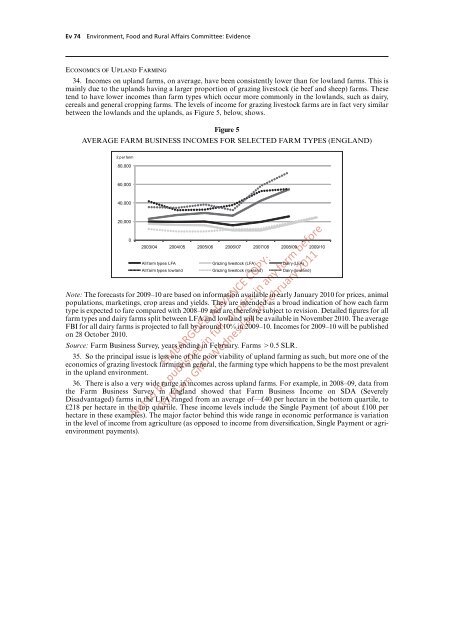Farming in the Uplands - ARCHIVE: Defra
Farming in the Uplands - ARCHIVE: Defra
Farming in the Uplands - ARCHIVE: Defra
You also want an ePaper? Increase the reach of your titles
YUMPU automatically turns print PDFs into web optimized ePapers that Google loves.
Ev 74 Environment, Food and Rural Affairs Committee: Evidence<br />
Economics of Upland <strong>Farm<strong>in</strong>g</strong><br />
34. Incomes on upland farms, on average, have been consistently lower than for lowland farms. This is<br />
ma<strong>in</strong>ly due to <strong>the</strong> uplands hav<strong>in</strong>g a larger proportion of graz<strong>in</strong>g livestock (ie beef and sheep) farms. These<br />
tend to have lower <strong>in</strong>comes than farm types which occur more commonly <strong>in</strong> <strong>the</strong> lowlands, such as dairy,<br />
cereals and general cropp<strong>in</strong>g farms. The levels of <strong>in</strong>come for graz<strong>in</strong>g livestock farms are <strong>in</strong> fact very similar<br />
between <strong>the</strong> lowlands and <strong>the</strong> uplands, as Figure 5, below, shows.<br />
Figure 5<br />
AVERAGE FARM BUSINESS INCOMES FOR SELECTED FARM TYPES (ENGLAND)<br />
£ per farm<br />
80,000<br />
60,000<br />
40,000<br />
20,000<br />
0<br />
2003/04 2004/05 2005/06 2006/07 2007/08 2008/09 2009/10<br />
All farm types LFA Graz<strong>in</strong>g livestock (LFA) Dairy (LFA)<br />
All farm types lowland Graz<strong>in</strong>g livestock (lowland) Dairy (lowland)<br />
Note: The forecasts for 2009–10 are based on <strong>in</strong>formation available <strong>in</strong> early January 2010 for prices, animal<br />
populations, market<strong>in</strong>gs, crop areas and yields. They are <strong>in</strong>tended as a broad <strong>in</strong>dication of how each farm<br />
type is expected to fare compared with 2008–09 and are <strong>the</strong>refore subject to revision. Detailed figures for all<br />
farm types and dairy farms split between LFA and lowland will be available <strong>in</strong> November 2010. The average<br />
FBI for all dairy farms is projected to fall by around 10% <strong>in</strong> 2009–10. Incomes for 2009–10 will be published<br />
on 28 October 2010.<br />
Source: Farm Bus<strong>in</strong>ess Survey, years end<strong>in</strong>g <strong>in</strong> February. Farms (0.5 SLR.<br />
35. So <strong>the</strong> pr<strong>in</strong>cipal issue is less one of <strong>the</strong> poor viability of upland farm<strong>in</strong>g as such, but more one of <strong>the</strong><br />
economics of graz<strong>in</strong>g livestock farm<strong>in</strong>g <strong>in</strong> general, <strong>the</strong> farm<strong>in</strong>g type which happens to be <strong>the</strong> most prevalent<br />
<strong>in</strong> <strong>the</strong> upland environment.<br />
36. There is also a very wide range <strong>in</strong> <strong>in</strong>comes across upland farms. For example, <strong>in</strong> 2008–09, data from<br />
<strong>the</strong> Farm Bus<strong>in</strong>ess Survey <strong>in</strong> England showed that Farm Bus<strong>in</strong>ess Income on SDA (Severely<br />
Disadvantaged) farms <strong>in</strong> <strong>the</strong> LFA ranged from an average of—£40 per hectare <strong>in</strong> <strong>the</strong> bottom quartile, to<br />
£218 per hectare <strong>in</strong> <strong>the</strong> top quartile. These <strong>in</strong>come levels <strong>in</strong>clude <strong>the</strong> S<strong>in</strong>gle Payment (of about £100 per<br />
EMBARGOED ADVANCE COPY:<br />
Not to be published <strong>in</strong> full, or part, <strong>in</strong> any form before<br />
00.01am GMT Wednesday 16 February 2011<br />
hectare <strong>in</strong> <strong>the</strong>se examples). The major factor beh<strong>in</strong>d this wide range <strong>in</strong> economic performance is variation<br />
<strong>in</strong> <strong>the</strong> level of <strong>in</strong>come from agriculture (as opposed to <strong>in</strong>come from diversification, S<strong>in</strong>gle Payment or agrienvironment<br />
payments).

















